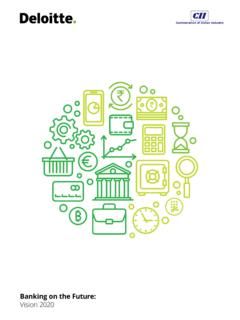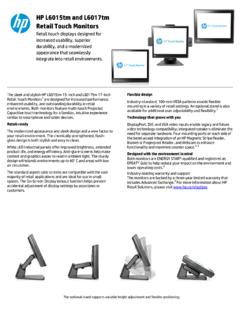Transcription of The great retail bifurcation - deloitte.com
1 The great retail bifurcationWhy the retail apocalypse is really a renaissance Deloitte provides industry-leading audit, consulting, tax, and advisory services to more than 85 percent of the Fortune 500 and more than 6,000 private and middle market companies. Our peo-ple work across more than 20 industry sectors to make an impact that matters delivering mea-surable and lasting results that help reinforce public trust in our capital markets, inspire clients to see challenges as opportunities to transform and thrive, and help lead the way toward a stronger economy and a healthy society. Deloitte is proud to be part of the largest global professional ser-vices network serving our clients in the markets that are most important to great retail bifurcationIntroduction | 2So what is really going on?
2 | 3 What s everyone missing? | 7 The impact on the retailer landscape | 12 Methodology | 17 Endnotes | 18 CONTENTSWhy the retail apocalypse is really a renaissance 1IT would seem that the retail industry is beset by an existential crisis. Every day, media and business journals declare a retail apocalypse is upon us, a day of reckoning when brick-and-mortar stores will turn to rubble and shopping malls to empty Conventional wisdom holds that traditional retail -ers have stopped growing, as shoppers, especially millennials, make more and more of their pur-chases online. Newspapers, with their almost daily reporting of store closings and merchant bankrupt-cies, drive home the storyline of an industry on the verge of collapse.
3 Conventional wisdom, how-ever, is often a poor substitute for true understanding. Indeed, when one digs into the facts about retail , one may find that much of this wisdom is actually false or at best, only partially true and that the picture is much more nuanced. To break with the orthodoxy re-quires that you take a microscopic approach to the data emerging from the re-tail sector and consider what gets lost in the conventional wisdom concerning the industry. Introduction Conventional wisdom serves to protect us from the painful job of thinking.
4 John Kenneth Galbraith (1908 2006), iconoclast economist, thinker, and diplomat2 The great retail bifurcation2 The economyWe asked ourselves: How might we gain a better understanding of the developments affecting retail ? Where should we even be looking? We undertook an extensive process, devoting the better part of a year to examining the retail environment; studying official data; surveying consumers; and drawing on the knowledge of our clients, friends in the industry, and our own industry specialists (see the Method-ology section at the end to learn more). To understand the changes afoot, you must start on the ground.
5 So to begin with, we looked at the US economy to see how it has performed over the past decade, a period that witnessed the collapse of the housing market, the great financial crisis, and the deepest and most severe recession to hit the nation since the great Depression. We studied the key measures impacting US households and consumers: household income, consumer sentiment, unemployment, and the housing market. On those fronts, US households appear to have recovered from the effects of the 2008 2009 great Recession. For instance, median income, according to the US Census Bureau, began falling in 2007 and bottomed out in 2012.
6 Since then, it has bounced back and as of 2016 stood at $57,617, slightly higher than it was in 2007 (figure 1).3 This suggests consumers wallets are fatter than they have been in recent years and finally on par with pre-recession , shopping habits are not simply a func-tion of income psychology plays a critical role in consumers willingness to open their wallets. So we looked at measures of consumer sentiment. In 2017, consumer confidence was the highest it s been since 2000, averaging , according to the Index of Consumer Sentiment, a monthly survey of US That confidence reflects the strength of the labor and housing markets.
7 Unemployment in the United States is percent, a 16-year low and a far cry from the percent rate in December The hous-ing market, which cratered during the financial cri-So what is really going on?Deloitte Insights | : US Census Bureau 1. Median income ($ thousands)2007 2008 2009 2010 2011 2012 2013 2014 2015 2016$58,000$56,000$54,000$52,000$50,000 Why the retail apocalypse is really a renaissance 3sis, has also fully recovered and stands at an all-time Such figures bear out consumers confidence. Together, these indices consumer sentiment, in-come, unemployment, and housing prices seem to indicate strong and robust consumers who are in-clined to loosen their purse strings, rather than frag-ile consumers who could signal an industry , we needed to dig even deeper into the data to see precisely what it was telling us.
8 Specifically, we examined additional future-oriented indicators GDP growth, the stock market value, household net worth, and household debt-servicing payments to see whether they painted a different picture of where the US economy might be headed. These measures indicate the appetite of businesses and consumers to seek opportunities and take risks. Again, we found that these num-bers do not imply retail disaster; in fact, the needles on these dials point up. While US GDP growth has been modest as of late, it has rebounded from negative growth during the recession and has been growing in a range of percent annu-ally, until recently when the pace of growth picked up: US GDP expand-ed at an annual rate of percent in the third quarter of 2017, the fastest rate in more than three years (figure 2).
9 7 More importantly, the outlook for the future has improved: Due partially to the 2017 tax reform bill, GDP is forecasted to grow around 3 percent in 2018, according to the Conference Further, the equity market has gone through the roof, with the S&P 500 stock index more than tripling from a low of 735 trillion in February 2009 to 2,663 trillion in February net worth of households has more than doubled since its recession low: from $45 trillion in Deloitte Insights | : IBIS 2. GDP change2007 2008 2009 2010 2011 2012 2013 2014 2015 2016 net worth of households has more than doubled since its recession low: from $45 trillion in 2009, to more than $95 trillion, and growing.
10 The great retail bifurcation42009, to more than $95 trillion, and growing, today (figure 2).10 Consumers are also financially healthi-er, as payments on household debt made up less than 10 percent of disposable income in 2017 (about 25 percent less than it was in 2009).11 Every measure we sur-veyed told a positive story, one of a robust economy and a consumer operating in a healthy financial landscape. Given this state, how then could we be on the verge of a retail apocalypse? So we shift-ed gears to look at the retail industry through a macro sectorPersonal income and spending represents nearly 70 percent of GDP,12 and, historically, GDP growth is tightly correlated with retail strength and a rise in re-tail sales.













